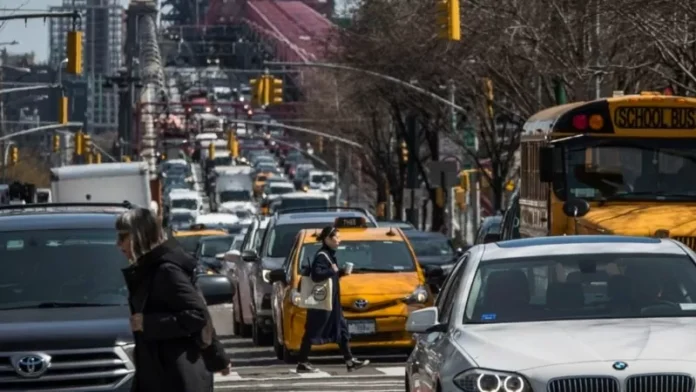New York City’s congestion pricing system, which was launched on January 5th, has been a hot topic of debate since its inception. The system, which imposes a $9 toll on most vehicles entering certain parts of Manhattan, aims to reduce traffic and fund mass transit in the city. However, on Wednesday, the Trump administration ordered a halt to the program, citing concerns about its impact on working class Americans and small business owners.
U.S. Transportation Secretary Sean P. Duffy announced the federal government’s decision to rescind its approval of the program in a statement, calling it a “slap in the face” to hardworking Americans. He also stated that the agency will work with the state on an “orderly termination” of the tolls.
President Donald Trump, whose properties including his namesake Trump Tower penthouse are located within the congestion zone, had previously promised to kill the plan as soon as he took office. He has repeatedly referred to it as a “massive, regressive tax” and has stated that it will hinder the city’s ability to bounce back economically.
While similar tolling programs have been successful in other global cities such as London, Stockholm, Milan, and Singapore, this is the first time such a system has been implemented in the United States. The Trump administration’s order has sparked criticism from congestion pricing supporters in New York City.
State Senator Andrew Gounardes, a Democrat, stated that by blocking this successful policy, Trump will be directly responsible for more traffic, crashes, air pollution, and slower buses. He also emphasized that the toll revenue was crucial for funding much-needed improvements and repairs for the city’s transit system, which serves 4 million riders daily.
The tolling system has been a divisive issue, with both advocates and opponents voicing their opinions. Transit advocates and environmentalists see it as a crucial step in reducing air pollution and making streets safer for pedestrians and cyclists, while also improving traffic flow for essential vehicles such as delivery trucks and emergency vehicles. However, many New Yorkers who own cars, particularly those living in the suburbs or areas with limited access to public transportation, have expressed their dislike for the high tolls.
Even New Jersey Governor Phil Murphy, a Democrat, has been fighting against the tolls and wrote a letter to Trump on Inauguration Day, urging him to kill the program. New York Governor Kathy Hochul, also a Democrat, had her reservations about the tolling system and halted its launch last June, citing concerns about its impact on the local economy. However, following Trump’s election, she revived the toll in November and reduced it to $9 for passenger vehicles. She has since praised the toll as a win for the city and has discussed the issue with the president multiple times.
The tolling plan was approved by New York lawmakers in 2019 but faced delays due to a federal environmental review during Trump’s first term. It was finally approved by President Joe Biden’s administration before its launch. Similar to other cities, the New York congestion fee varies depending on the time and size of the vehicle. Trucks and larger vehicles pay a higher rate, while the fee drops to $2.25 for most cars during overnight hours.
Despite facing several lawsuits trying to halt its launch, including from the state of New Jersey, unionized teachers in New York City, a trucking industry group, and local elected leaders in the surrounding areas, the tolling system has prevailed.
In conclusion, the Trump administration’s decision to halt New York City’s congestion pricing system has sparked controversy and criticism from supporters of the program. However, the tolling system has been proven to be successful in other global cities and is a crucial step in reducing traffic and funding mass transit in New York City. It is essential to find a solution that benefits all parties involved and ensures the city’s continued progress and sustainability.

